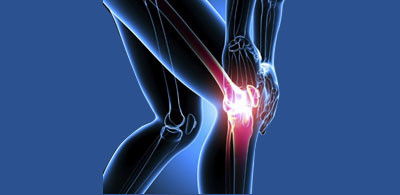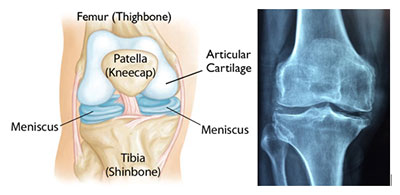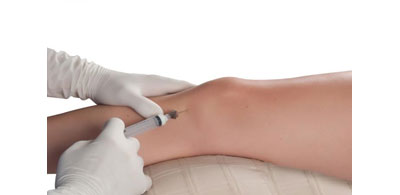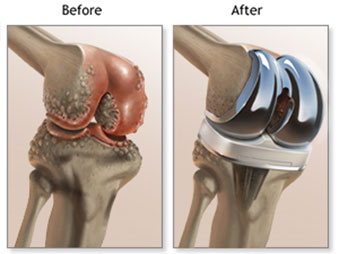Treatments for Knee Osteoarthritis

Arthritis of the Knee
- Arthritis is inflammation of one or more of your joints.
- Pain, swelling, and stiffness are the primary symptoms of arthritis.
- Any joint in the body may be affected by the disease, but it is particularly common in the knee.
An estimated 54 million adults in the United States are affected by some form of arthritis
- The number of adults with OA is expected to increase as baby boomers age and enter into age groups with higher prevalence of arthritis
- By 2040, the number of adults with arthritis is projected to increase to 78.4 million, most of whom will have OA
Normal anatomy of the knee.

- The knee is the largest and strongest joint in your body.
- It is made up of the lower end of the femur (thighbone), the upper end of the tibia (shinbone), and the patella (kneecap).
- The ends of the three bones where they touch are covered with articular cartilage, a smooth, slippery substance that protects and cushions the bones as you bend and straighten your knee.
Although there is no cure for arthritis, there are many treatment options available to help manage pain and keep people staying active.
- Medications
- Your doctor may prescribe medications to help relieve pain and to treat underlying conditions
- These include non-steroid anti-inflammatories (Motrin, Ibuprofen, Aleve) and acetaminophen (Tylenol)
- Therapy
- Strengthening the muscles around your knee will make it more stable. Training is likely to focus on the muscles on the front of your thigh (quadriceps) and the muscles in the back of your thigh (hamstrings).
- Exercises to improve your balance also are important.
- Alternative medicine
- Glucosamine and chondroitin. Study results have been mixed about the effectiveness of these supplements for relieving osteoarthritis pain. People who have moderate to severe arthritis pain appear to get the most benefit from these supplements.
- Acupuncture. Research suggests that acupuncture may help relieve knee pain caused by osteoarthritis. Acupuncture involves the placement of hair-thin needles into your skin at specific places on your body.
- Injections
- In some cases, your doctor may suggest injecting medications or other substances directly into your joint. Examples include:
- Corticosteroids. Injections of a corticosteroid drug into your knee joint may help reduce the symptoms of an arthritis flare and provide pain relief that lasts a few months. These injections aren’t effective in all cases.
- Hyaluronic acid. A thick fluid, similar to the fluid that naturally lubricates joints, hyaluronic acid can be injected into your knee to improve mobility and ease pain. Although study results have been mixed about the effectiveness of this treatment, relief from one or a series of shots may last as long as six months.
- Platelet-rich plasma (PRP). PRP contains a concentration of many different growth factors that appear to reduce inflammation and promote healing. These types of injections tend to work better in younger people and in people with mild arthritis.
- In some cases, your doctor may suggest injecting medications or other substances directly into your joint. Examples include:

- Surgery
- Before making any decision, consider the pros and cons of both nonsurgical rehabilitation and surgical reconstruction in relation to what’s most important to you. If you choose to have surgery, your options may include
- Arthroscopic surgery. Arthroscopy may be used to remove loose bodies from your knee joint, remove or repair damaged cartilage (especially if it is causing your knee to lock), and reconstruct torn ligaments.
- Partial knee replacement surgery. In this procedure (unicompartmental arthroplasty), your surgeon replaces only the most damaged portion of your knee with parts made of metal and plastic.
- Total knee replacement. In this procedure, your surgeon cuts away damaged bone and cartilage from your thighbone, shinbone and kneecap, and replaces it with an artificial joint made of metal alloys, high-grade plastics and polymers.
- Before making any decision, consider the pros and cons of both nonsurgical rehabilitation and surgical reconstruction in relation to what’s most important to you. If you choose to have surgery, your options may include

A New and Innovative Treatment

Genicular Neurotomy (aka Genicular Nerve Ablation)
- Genicular Neurotomy (aka ablation) is a brand new, innovative option for treating knee pain without surgery.
- By selectively applying a sophisticated type of radio wave to the nerves surrounding the knee (the genicular nerves), one can effectively relieve pain in the knee from any number of causes
Indications
Perhaps the greatest advantage of genicular neurotomy is the fact that the entire procedure is performed OUTSIDE the knee capsule. This is what allows it to succeed where other procedures like cortisone injections, hyaluronic acid injections, and even surgery fail.
In fact, this procedure can be done up to one month before knee surgery and even after surgery.
How Does It Work?
- The procedure uses a technology called Radiofrequency Ablation (RFA) to stun the painful nerves and prevent the signals from reaching the brain.
- This technology has been used for decades with excellent success, traditionally to treat pain in the neck and back.
- The nerves grow back over time which makes the procedure reversible if necessary.
This procedure is performed in 2 phases:
Diagnostic Genicular Nerve Block – This procedure consists of placing a small amount of a local anesthetic, like Lidocaine or Bupivacaine, on the genicular nerves to test the patient’s response and see if there is sufficient enough relief in the knee to justify performing a therapeutic neurotomy.
Genicular Nerve Ablation – This is the therapeutic portion of the treatment whereby the physician will perform a radiofrequency ablation (RFA) of the genicular nerves, thus alleviating pain to the knee and restoring function.
How Many Treatments?
- Before performing a genicular neurotomy, your doctor will first schedule you for a diagnostic genicular nerve block to see if you are a candidate for the ablation procedure.
- The pain relieving effects of the genicular neurotomy can last up to a year or longer.
What Are The Benefits?
- It is a minimally invasive, nonsurgical treatment option with the potential to relieve pain where other more conventional therapies have failed.
- For those patients where a knee replacement is the only option, genicular nerve neurotomy can offer a number of benefits in the postoperative phase.


